There are signs that the income squeeze is finally starting to ease across Europe. Food inflation remains high, but energy prices have peaked and should start to fall in most markets. However, inflation is still expected to be well above pre-crisis levels throughout 2023 and 2024. In the UK, concerns over core inflation mean that the Bank of England will almost inevitably increase interest rates further, adding to people’s mortgage and credit card costs.
Across every market, consumer confidence has recovered from its 2022 low point. They are still worried about their financial prospects, but there are encouraging signs that they believe that the worst is over. Analysis of Mintel consumer confidence data shows that it takes at least six months for changes in GDP to feed through into consumer confidence. Changes in inflation hit quicker but have a less significant and shorter-lived impact on consumer confidence.
Getting the balance right: What winning brands will do
An economic recovery will inevitably change what consumers want from brands, but timing is crucial. If a change happens too early, brands risk looking insensitive; too late, they’ll miss out on the opportunities that a rising market will inevitably offer.
Winning brands are the ones who get the balance right between meeting what consumers want currently, while simultaneously doing the work in the background on innovation – so they’re ready to pivot seamlessly when consumers are confident enough to loosen the purse strings again. Brands that get this balance wrong risk losing out to rivals who are better positioned to tap into improving consumer mindset. In this blog we examine four key ways we think consumers’ attitudes towards spending will shift when the European economic recovery begins.
1. From strict budgeting to big-ticket spending
Now
There’s no escaping the fact that some consumers are being forced to cut back, while even those who are doing okay are still changing the way they shop. In a cost-of-living crisis, discounters and private-label products are always going to thrive, with consumers having spent the last few years delaying big-ticket purchases.
Next
As confidence returns and people feel more secure, the upgrade cycle will start to pick up speed. Essential, but unglamorous, products like domestic appliances including refrigerators or washing machines, tend to be the first hit when budgets are under pressure. However, they’re also the first to benefit when consumer spending starts to recover.
2. From safety first to more experimentation
Now
During an income squeeze, efficacy and functionality move up the list of priorities. ‘Nice-to-haves’ are a luxury in tough times. Consumers can also be reluctant to experiment as they become more likely to stick with familiar products that they know will deliver on quality and efficacy. This safety-first approach can help established brands fight back against challengers and private label.
Next
As the economy slowly recovers, consumers will be more willing to experiment with exciting new brands, products and concepts. After the Global Financial Crisis, legacy brands were caught off guard by a wave of disruptive innovation from startups, which coincided with greater willingness from consumers to gamble on new products, creating major challenges for legacy brands.
3. From everyday indulgence to a more lighthearted spending approach
Now
The lipstick effect is a cliché for a reason. Whatever a consumer’s financial position, they still need an escape from the gloom. At the upper end of the market, prestige brands can certainly capitalise, but even at the value end, there’s always a role for indulgence—including a luxury ready-meal instead of a night out or premium skincare products.
Next
During tough times, conspicuous consumption looks crass. However, when spirits lift there’s much more room for frivolity. As the economic recovery picked up after the Global Financial Crisis, we saw a greater emphasis on products that had ‘fun’ as the chief selling point. This included lobster and gold flake-topped takeaway, with the mood going from serious to playful and bold.
4. From value with values to paying extra for products making positive social impact
Now
When consumers are struggling to pay the bills, issues like sustainability and social responsibility tend to move to the background. They don’t disappear altogether, but value and functionality need to be locked in before broader factors can come into play. The winning proposition is to combine value with values—saving money and the planet.
Next
When money’s tight people look for efficacy and value first. Value and functionality will always be at the core of a product’s appeal, but when people are feeling better off they’re more likely to be prepared to pay a little more for products and experiences that they believe will have a positive social impact, and support the causes they care about most.































